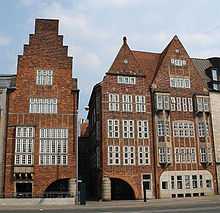Böttcherstraße

_by_Bernhard_Hoetger_(1936).jpg)




Böttcherstraße is a street in the historic centre of Bremen, Germany. Only about 100 m (330 ft) long, it is famous for its unusual architecture and ranks among the city's main cultural landmarks and visitor attractions. Most of its buildings were erected between 1922 and 1931, primarily as a result of the initiative of Ludwig Roselius, a Bremen-based coffee-trader, who charged Bernhard Hoetger with the artistic supervision over the project. The street and its buildings are a rare example of an architectural ensemble belonging to a variant of the expressionist style. Several of the houses can be classed as Brick Expressionism. Since 1973, the ensemble is protected by the monument protection act.[2]
Overview
Roselius, a sympathiser of National Socialism pursued Völkisch-Nordic cultural ideas influenced by the ideologists Julius Langbehn and Herman Wirth, involving a belief in the irreplaceable value of the Nordic race. He aimed to have these ideas materialise in Böttcherstraße (Roselius: "The re-erection of Böttcherstraße is an attempt to think in a German way" - "I want, and that is the deepest aim of what was created in Böttcherstraße, to break the spell of the banishment the ill-informed Romans sentenced our people to, which still weighs upon us..."). Although Roselius and Hoetger paid tribute to Hitler as the "Bringer of Light" on a relief at the entrance, the Führer rejected this variant of völkisch art in a Reichsparteitag speech on 10 September 1936, in which he dismissively referred to Böttcherstraßenkunst ("Böttcherstraße art").[3] On the one hand the NSDAP dressed Böttcherstraße down as reflecting a "divergent view of culture", on the other hand, the street was listed as an architectural monument on 7 May 1937, as an "example of the degenerate art of the Weimar period".
History
The history of Böttcherstraße goes back to the Middle Ages. It constituted an important link between the market square and the Weser river. It was traditionally inhabited by coopers (Northern German: Böttcher). When the harbour was relocated in the mid-19th century, Böttcherstraße's importance began to fade.
In 1902 (some sources say 1906), Ludwig Roselius, under pressure from the previous owners, bought the house at 6 Böttcherstraße (today's Ludwig Roselius Museum) and made it the headquarters of his company (which would later produce the HAG coffee brand). He bought other lots in the street throughout the following years. In the years after World War I, further offices, the HAG-Haus, the Haus St. Petrus and the House of the Seven Lazy Brothers. The houses were built of the then typical materials, brick and sandstone.
In contrast to these buildings, in 1926, Ludwig Roselius had the Paula Modersohn-Becker-Haus built, to serve as a museum dedicated to the painter Paula Modersohn-Becker. The building's external walls have relief-like decorations, its internal rooms follow principles of organic architecture.
In 1931 the Atlantis House (Haus Atlantis) was completed. Its distinctive style and materials (glass, steel and concrete) produced a further striking contrast to the other structures. The Robinson Crusoe House (Robinson-Crusoe Haus) was also erected in 1931.
In 1944, large proportions of Böttcherstraße were destroyed. By 1954, the Kaffee HAG company had restored most of the facades to their original state.
In 1979, Ludwig Roselius Jr. sold the Kaffee HAG company, along with Böttcherstraße, to General Foods. Two years later, he bought Böttcherstraße back. Since then, it has been privately owned.
In 1989 renewed severe damage to the building fabric was noticed. The Sparkasse Bremen bank bought the whole street and all its buildings, except Haus Atlantis. Restoration was completed by 1999.
In 2004 ownership passed to a foundation (Stiftung Bremer Sparer Dank). It is now administrated by Böttcherstraße GmbH, a limited company and subsidiary of Sparkasse Bremen.
Present
Today, Böttcherstraße is one of the major tourist attractions of Bremen. It contains several art museums (Museen Böttcherstraße), Arts and crafts workshops, bars, restaurants, shops and a hotel. Nearly all buildings and plots are owned by the foundation. A major attraction is the carillon of Meissen porcelain bells at the Glockenspiel House which chimes three times a day.[4]
Bibliography
- Ludwig Leidig: Bombshell. Sbpra 2013, ISBN 978-1-62516-346-2
- Arn Strohmeyer: Der gebaute Mythos: das Haus Atlantis in der Bremer Böttcherstraße – ein deutsches Missverständnis. Donat, Bremen 1993, ISBN 3-924444-67-6
- Arn Strohmeyer: Parsifal in Bremen. Richard Wagner, Ludwig Roselius und die Böttcherstraße. VDG, Weimar 2002, ISBN 3-89739-263-1
- Hans Tallasch (Hrsg.): Projekt Böttcherstraße. Aschenbeck & Holstein, Delmenhorst 2002, ISBN 3-932292-29-4
See also
References
- ↑ Elisabeth Schmidle (2006). "Schandmal oder Mahnmal" (pdf). Der Bürger im Staat (in German). Stuttgart, Germany: Landeszentrale für politische Bildung Baden-Württemberg. p. 188 (54 pdf). Retrieved 2010-07-23.
- ↑ Database of Landesamt für Denkmalpflege Bremen #0209,T (German)
- ↑ Kristina Hoge (inaugural dissertation), Self-portraits in the face of the threat of Nazism, in German, "We have nothing to do with those elements that only know National Socialism from hearsay and thus easily confuse it with undefinable nordic phrases, seeking out some mythical Atlantic culture to find their motifs. National Socialism rejects that kind of Böttecherstraße art most sharply". (Hitler)
- ↑ "Böttcherstraße: Welcome". Böttcherstraße GmbH. Retrieved 27 January 2014.
External links
| Wikimedia Commons has media related to Böttcherstraße. |
| Wikimedia Commons has media related to Bernhard Hoetger. |
Coordinates: 53°04′30″N 08°48′20″E / 53.07500°N 8.80556°E
